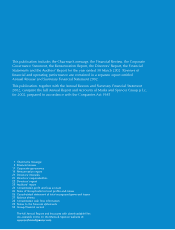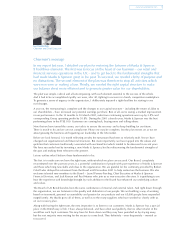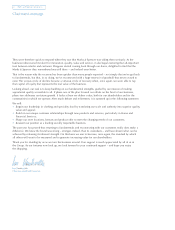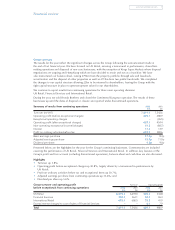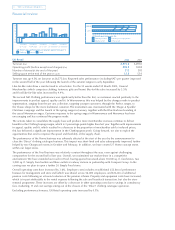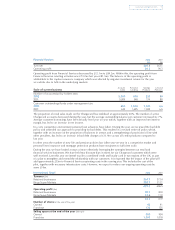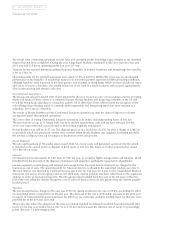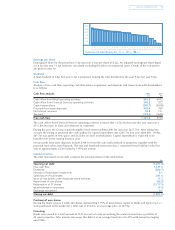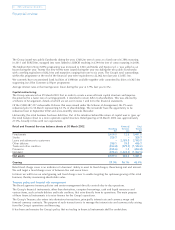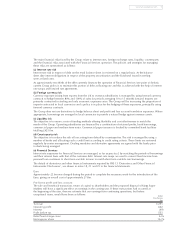Marks and Spencer 2002 Annual Report Download - page 3
Download and view the complete annual report
Please find page 3 of the 2002 Marks and Spencer annual report below. You can navigate through the pages in the report by either clicking on the pages listed below, or by using the keyword search tool below to find specific information within the annual report.
Chairman’s message
In my report last year, I detailed our plan for restoring the fortunes of Marks & Spencer.
It had three elements. The first was to focus on the heart of our business – our retail and
financial services operations in the UK – and to get back to the fundamental strengths that
had made Marks & Spencer great in the past. To succeed, we needed clarity of purpose and
no distractions. The second element of the plan was therefore to stop all activities which
were non-core or making a loss. Thirdly, we needed the right capital structure to make
our balance sheet more efficient and to generate greater value for our shareholders.
The plan was simple, radical and all-encompassing, with each element essential to the success of the whole.
And it had to be accomplished rapidly: we were, after all, fighting to recover in a harsh, competitive marketplace.
To generate a sense of urgency in the organisation, I deliberately imposed a tight deadline for starting to see
real changes.
A year on, the restructuring is complete and the changes to our capital structure – including the return of £2bn to
our shareholders – have increased our potential earnings per share. Best of all, we’re seeing a marked improvement
in our performance. In the 12 months to 30 March 2002, sales from continuing operations were up by 3.8% and
corresponding Group operating profits by 30.8%. During the 2001 calendar year, Marks & Spencer was the best
performing share in the FTSE 100. Customers are coming back, buying more and telling others.
Now that we have turned the corner, our task is to secure the recovery and to keep building for our future.
There is much to do and we are not complacent. Phase one may be complete, but the plan moves on as we set
about growing the business and regaining our leadership in the UK market.
Before we look forward, it is worth reflecting on why the turnaround has been so relatively swift. Yes we have
changed our organisational and financial structures. But more importantly, we have tapped into the values and
qualities that customers traditionally associated with our brand but which tended to be obscured in recent years.
We have succeeded not by inventing a new Marks & Spencer, but by rediscovering the fundamental strengths of
the past and making them relevant to the present.
Let me outline what I believe these fundamentals to be.
The first is to make sure we have the right team, without which no plan can succeed. Our Board, completely
reconstituted over the past two years, is a powerful combination of people with past experience of Marks & Spencer
and those who bring new skills and ideas to the organisation. We are grateful for the continuity provided by Robert
Colvill who delayed his retirement from the Board until December 2001 to help restructure the business. We also
welcome talented new members to the Board – Laurel Powers-Freeling, Chief Executive of Marks & Spencer
Financial Services, and Jack Keenan and Paul Myners who join us as non-executive directors. It is gratifying to see
how the experience and knowledge brought by each addition to the Board has enhanced our underlying culture
and values.
The Board of UK Retail benefits from the same combination of internal and external talent. And right down through
the organisation, we are fortunate in the quality and dedication of our people. We are building a way of working
based on teamwork, personal accountability and passion for our products and our 65,000 people have responded
magnificently. My thanks go to all of them, as well as to the many suppliers who have worked so closely with us
on our recovery plan.
Along with having the right team, the next imperative is to listen to our customers. Marks & Spencer has a special
place in the British way of life. I have always believed, and have often said publicly, that no other retailer in the
world has such loyal customers. We may have let them down and they may have punished us by staying away,
but the vast majority were waiting for the excuse to come back. They definitely – even desperately – wanted us
to succeed.
www.marksandspencer.com 1
Luc Vandevelde
Chairman and Chief Executive


